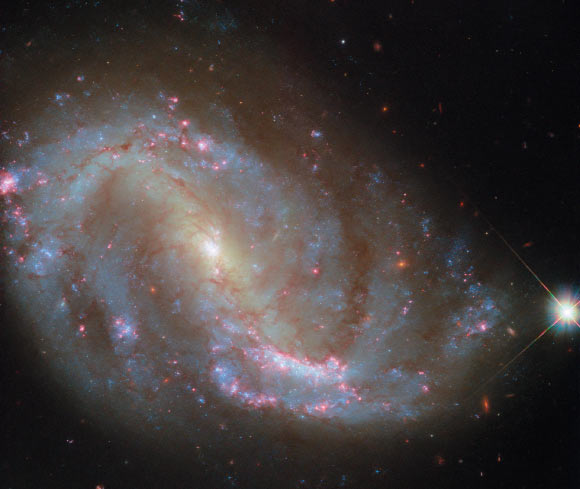NGC 7496 is a barred spiral galaxy located approximately 24 million light-years away in the constellation of Grus.

This Hubble image shows NGC 7496, a barred spiral galaxy some 24 million light-years away in the constellation of Grus. Image credit: NASA / ESA / Hubble / R. Chandar / J. Lee / PHANGS-HST Team.
NGC 7496 was discovered on September 5, 1834 by the English astronomer John Herschel.
Otherwise known as ESO 291-1, LEDA 70588 and IRAS 23069-4341, this galaxy is about 70,000 light-years across.
NGC 7496 is a member of the NGC 7582 group, a gathering of almost ten large galaxies.
The galaxy is also classified as a type II Seyfert galaxy with high star formation rate.
At the center of NGC 7496 lies an active galactic nucleus, a supermassive black hole that feasts on gas.
“Hubble first observed NGC 7496 as part of the Physics at High Angular resolution in Nearby GalaxieS (PHANGS) program,” the Hubble astronomers said in a statement.
“This program has enlisted the abilities of several powerful astronomical observatories, including the Atacama Large Millimetre/submillimetre Array, ESO’s Very Large Telescope, and the NASA/ESA/CSA James Webb Space Telescope, in addition to the NASA/ESA Hubble Space Telescope.”
“NGC 7496 was the first galaxy in the PHANGS sample that Webb observed.”
“Each of these observatories offers a different perspective on this well-studied galaxy.”
“With its unique ultraviolet capabilities and fine resolution, Hubble’s view reveals young star clusters bursting with high-energy radiation.”
“Hubble’s observations of NGC 7496 help to reveal the ages and masses of these young stars, as well as the extent to which their starlight is blocked by dust.”
“A previous Hubble image of NGC 7496 was released in 2022,” they added.
“Today’s image incorporates new data that highlight the galaxy’s star clusters, which are surrounded by glowing red clouds of hydrogen gas.”







